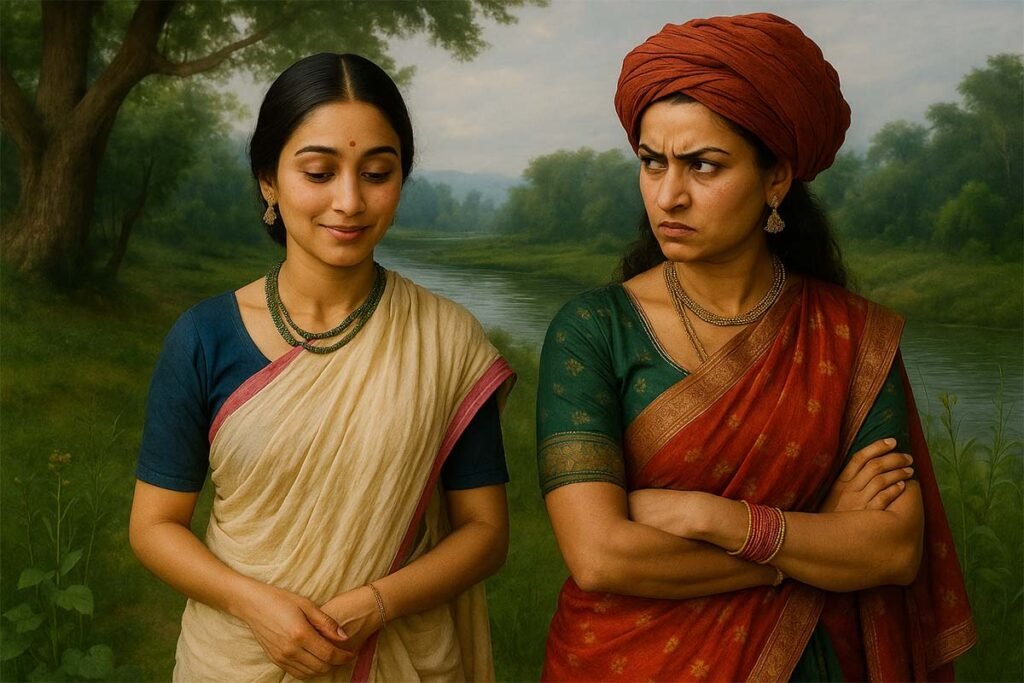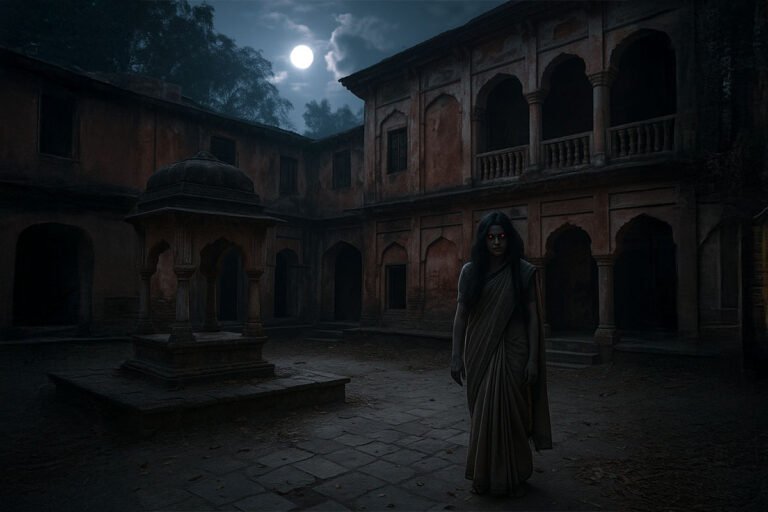Long ago, in the kingdom of Kangleipak (now Manipur), lived a nobleman named Khulen Nganba. He had two wives, the gentle and kind Yangkhuleima, and the cunning Sangkhuleima. The elder wife, Yangkhuleima, had a daughter named Sandrembi, while Sangkhuleima had only one child, a daughter named Chaisra. Though the girls shared the same father, their mothers’ rivalry would shape both their destinies.
The Cruel Plot Beneath the Fig Tree
After Khulen Nganba’s death, the two widows struggled to make ends meet, selling vegetables and fish from the lake. Yangkhuleima’s gentle ways often brought her luck. One day, she caught a net full of fish, while Sangkhuleima only hauled in snakes and reptiles. Jealousy burned in Sangkhuleima’s heart.
As they rested beneath a fig tree, Sangkhuleima climbed up and, pretending to be generous, dropped sweet fruits for the elder widow. But soon, she asked Yangkhuleima to close her eyes and open her mouth for a “special treat.” With cold malice, she tipped her basket of snakes down to Yangkhuleima, who, unsuspecting, swallowed them and died instantly from their bites.
Sangkhuleima dragged her rival’s body to the lake and pushed it into the water, telling everyone that Yangkhuleima had drowned. But fate intervened, the body transformed into a tortoise, its soul lingering near her daughter, Sandrembi.
Orphaned and Alone
From that day, Sangkhuleima and Chaisra treated Sandrembi with cruelty, forcing her to do all the work and giving her only scraps to eat. Yet, Sandrembi’s spirit remained gentle and resilient.
One night, Sandrembi’s mother appeared to her in a dream, revealing the truth of her death. “My child,” the spirit said, “bring the tortoise from the lake and keep it in a pitcher for five days. Then, I can return to you.” Sandrembi followed her mother’s instructions, but her jealous stepsister discovered the secret before the fifth day. Feigning illness, Chaisra insisted she could only be cured by tortoise meat.
Sangkhuleima forced Sandrembi to cook the tortoise, ignoring her tears. As the pot boiled, Sandrembi heard her mother’s anguished voice, but she could do nothing. The cruel stepmother and stepsister feasted on the meat and tossed the bones aside.
The Sparrow’s Song
Again, Sandrembi’s mother appeared in a dream. “Gather my bones, cover them in a basket, and leave them for seven days,” she instructed. Sandrembi obeyed, but her longing was too great, she peeked into the basket before the seventh day. At once, the bones transformed into a sparrow, which fluttered away, leaving Sandrembi more alone than ever.
From Rags to Royalty
Years passed. Sandrembi grew into a beautiful and kind woman, though dressed in tatters. Chaisra, in contrast, wore fine clothes but grew spiteful and unattractive.
One day, King Sentreng Apanba came hunting by the river where the sisters fetched water. While Chaisra boasted and showed off her attire, the king’s eyes were drawn to Sandrembi’s gentle beauty and grace. He chose Sandrembi to be his queen, and after a grand wedding, she moved to the palace and bore a son, Machi Sana Melei Khomba.
Envy festered in the hearts of Sangkhuleima and Chaisra. Together, they plotted Sandrembi’s downfall. Inviting her home for a feast, they hid her clothes under a bed. When Sandrembi crawled under to retrieve them, Sangkhuleima poured scalding water over her, killing her instantly.
After Sandrembi’s tragic death, Chaisra stole her stepsister’s fine clothes and disguised herself as the queen. Dressed in Sandrembi’s garments, she returned to the palace, claiming to be the rightful queen. At first, the king was startled—there was something odd about his “queen.” He studied her closely and said with anger, “You are not my queen, whose face is as fair as a lily. You are disfigured.”
Chaisra tried to explain away the differences. “I wept for my son and for you every day,” she said, “and the tears and sorrow changed my looks.” The king, however, couldn’t help but notice Chaisra’s long nose, deep-set eyes, and bushy eyelids, features so unlike gentle Sandrembi. Still, he held back, waiting for a clear opportunity to prove whether she was telling the truth or not. Suspicion weighed heavy on his heart as he watched and waited, determined to find out if this woman was truly his queen.
The Pigeon Queen
Sandrembi’s soul did not rest. She transformed into a pigeon and flew to the royal garden, where she sang sad, mysterious songs about the king’s forgotten queen and the woes of her little prince. The royal gardener reported the songs to the king, who tried to comfort the bird and keep it safe.
But Chaisra, ever watchful, seized her chance. While the king was away, she caught and killed the pigeon, cooking its meat for a meal. When the king returned, he refused to eat the flesh and buried the remains behind the royal kitchen.
The Fruit Maiden
From the grave of the pigeon grew a lush fruit plant, heavy with golden fruit. Chaisra plucked the fruit and gave it to a wandering monk, who kept it in a jar, noticing that it always vanished or reappeared in mysterious ways.
One day, the monk awoke early and witnessed a miracle, a beautiful maiden emerged from the fruit to sweep and cook in his home. Realizing she was Sandrembi, the monk brought her to the palace.
Chaisra tried to claim her place as queen, but the king recognized something was wrong. The two women quarreled over who was the true queen.
Trial by Ordeal
To settle the matter, the king declared a trial by ordeal. Chaisra was given a sharp, gleaming sword and Sandrembi was handed only a rusty knife. Chaisra struck first, but her sword became dull and could not harm Sandrembi. Suddenly, the rusty knife flew from Sandrembi’s hand and cut off Chaisra’s head.
Justice was restored. Sandrembi reclaimed her place as queen, her son was embraced, and the palace once again knew peace. The people of Kangleipak remembered Sandrembi’s trials and virtues, telling her story for generations as a reminder that goodness and truth can never be buried for long.








